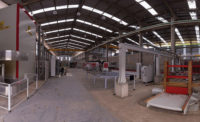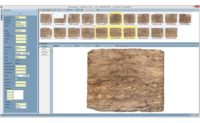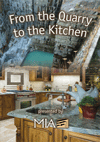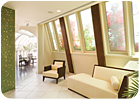
Principal Designer Christopher Grubb of Arch-Interiors Design Group, Inc. of Beverly Hills, CA, has been noticing a number of hospitality design trends lately. First and foremost, the designer has noticed that clients are moving away from stark white-on-white, beige-on-beige concepts. "The idea now is see and be seen," Grubb said. "People are adding elements they don't have at home, like a lot of color and textures that are both visually and emotionally exciting."
One of the main trends that has stemmed from this concept involves the mixing of materials that complement each other, while also adding a textural quality and architectural element to the space. "It is really exciting to see what is happening with different materials on the market today," said the designer. "There are always new combinations of things such as porcelain, glass and marble done in unique patterns."
Combinations of contrasting colors, the mixing of square and rectangular shapes and the variation of finishes such as polished, semi-polished and matte allow for more design options. Furthermore, the blend of different stone and tile materials can add interest by giving a space more depth and texture, while also helping to set a specific mood or tone, whether it is calming or bold, elegant or simple, or modern or contemporary.
"Designs used to be very clean and luxurious because of the quality of stone and tile," Grubb said. "Now, you need that extra element. One of the challenges of being a designer is to push the envelope and create a conversation piece -- something that will be memorable for the user. We are constantly challenging ourselves to ensure that people are really enjoying and appreciating design."
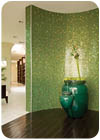
Medical Luxury
Grubb recently worked on the design of the ORA Dentistry Spa on Rodeo Drive in Beverly Hills, CA, which has been referred to as the "luxury destination of the new must-have pampered treatment when visiting a dentist." The space was designed to reflect a soothing experience versus a painful memory, and features a Zen-like style using a combination of tile materials to enhance the calming space.
"Our challenge was to make it aesthetically pleasing like a spa, yet still give it a clean medical feel," said Grubb, adding that the client allowed the designers total freedom in combining these two elements.
Flooring throughout most of the public spaces of the 3,000-square-foot penthouse is comprised of 18- x 18-inch Casa Dolce Casa porcelain tiles from Longust Distributing, Inc. of Anaheim, CA. According to Grubb and Senior Designer, Jennifer Culp, porcelain was selected for its texture, durability and ease of maintenance as well as its aesthetics. "We really liked the quality and the sandy beige color of this particular limestone," said Grubb. "It was a very appropriate choice for this kind of spa."
Additionally, curved waterwall features are located in the main lobby, as well as at the back entrance, creating a nice flow from one end of the space to the other. The walls are clad in 1- x 1-inch green glass tiles from Bisazza, which add a "punch of color" to the spa, according to the designers. "The material is green -- a good color that most people like and react to," said Grubb, adding that subtle gold hints add a play of contrast to the tile.
"The glass tiles are a beautiful vibrant green that matches the vegetation outside," Culp added. "It really pulls the nature inside and gives the space a nice calm feeling for the patients while they are waiting."
Complementing the green mosaic tiles, the reception desk countertop was fabricated from a green onyx slab, which was supplied by Stone Resources of West Hills, CA. The countertop is lit from underneath, adding a beautiful glow to the space, according to the designers.
Each treatment room is distinctively decorated, allowing customers to enjoy their favorite elements of design, whether it is sleek and modern or plush and warm-toned. "The medical spa was such a forward-thinking idea and a big risk, and we weren't sure what was going to happen with it," said Grubb. "Dr. [Sam David] Saleh's clients love it. It is definitely a great showplace for his notoriety and the quality of what he does."
"Everyone is thrilled with the end result, and have found it to be an innovative idea and project overall," Culp added.
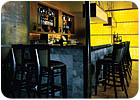
Elegant dining
Dick Clark of Dick Clark Architecture also recently completed a project in the hospitality sector. He was challenged to transform a nearly 100-year-old masonry building in downtown Austin into the Kenichi Restaurant, while retaining as much of the original structure as possible. And, the blend of slate and granite further enhanced the elegant feel of the dining space.
"The building was in sad shape, and we had to gut it inside and out," said Clark. "The space contained some interesting wood trusses, which we were able to keep, and it is one of the many special architectural details of the space."
According to Clark, the sushi restaurant owners were looking to establish a "Pan-Asian happening bar and sushi restaurant." "The primary thing was to seat as many people comfortably as we could," he explained. "The client also wanted some special seating. We installed large booths called 'Rock Star' booths, which fit six people and have curtains surrounding them for privacy. There is also a private dining area that has shoji screens which can be opened or closed."
After establishing a dark green color palette, Indian Tropical Green granite from Austin Granite & Marble (AG&M) of Austin, TX, was selected for the bar top in the main bar area, as well as for countertops in the sushi bar section. "Granite is indestructible, easy to clean and looks great," said Clark. Further enhancing the space, the base of the bar features 12- x 12-inch tiles of slate from Travis Tile of Austin, TX. Another unique feature of the space is a textured granite wall, which is located along the back of the restaurant.
Stone and tile were carried outside, as the exterior of the building features black granite and ceramic tile, which according to the architects, creates a striking presence from the street. "In the evening, the black granite facade fades into the night sky, framing views of an elegant and dramatic interior," according to a design statement from the firm.
"Maintenance is the main reason for stone and tile usage in restaurant designs," said Clark. "Our firm has tried a lot of different countertops materials such as nickel, steel and wood, and we had problems. You don't want to see grout, and you don't want to use anything that can chip or discolor, so that is why we tend to use granite. It is the most maintenance-free surface that we have found, and it holds up better than anything we have tried."
Over the years, Clark has been noticing that more and more money is spent on establishing elegant dining spaces. "The level of sophistication in the dining area is so much greater than it was 15 years ago," he said. "Today, people really appreciate not only good food, but fine design as well. Customers aren't just grabbing a bite to eat, but rather making dinner a whole evening out. In this essence, they are demanding more interesting designs and environments, whether it be casual or formal, light or dark, cozy or gregarious."
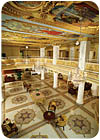
French Resort
The French Lick Resort Casino in French Lick, IN, recently underwent an extensive renovation, which included a stone and tile restoration, as well as the addition of stone and tile in new areas throughout the space. The property's historic features were carefully restored while modern amenities were incorporated to enhance travelers' experience. For the renovation of two hotels within the resort, WorthGroup of Englewood, CO, provided interior design services to the Architect of Record, GS Ridgway and Associates Inc., as well as serving as the Architect of Record and Interior Designer for a new casino, event and conference center and parking structure.
"It's a beautiful historic property from the turn of the last century," explained Bryan Hamlin, WorthGroup's Vice President of Design. "It has a French feel to it, and an existing vocabulary that is historic in nature. The sense of arrival and structure, and the stone detailing and scale of the property were extrapolated from characteristics of the existing French Lick Springs Hotel."
The main lobby of the French Lick Springs Hotel features multi-colored stone mosaic medallions, which were all restored by an historic preservation company, while stone flooring and granite vanity tops were used in guest rooms. "Everything we did [for the entire resort] was derived from that lobby," explained Brian Fagerstrom, Project Manager with WorthGroup.
As a result, stone floor medallions can also be found in the area surrounding the Grande Colonnade restaurant. Encompassing the decorative pieces are large-format porcelain tiles.
One of the more luxurious amenities of the French Lick Springs Hotel is the spa, which exhibits a more contemporary flair compared to other areas of the establishment, according to Hamlin, as it features glass mosaic walls as well as stone flooring. "The interior design team took more freedom with the color originally used in the lobby," he said. "They selected more dynamic types of tile, like glass, which is more reflective and more modern, and used it in an abstract installation. It is a really clean installation that complements the overall resort."
WorthGroup's Interior Designer, Carissa Thompson, designed the spa at the client's request to "consider what the spaces would make someone feel like while there for a treatment." "They were very interested to know what the stone and tile would do to the ambiance," she said. "I think that [stone/tile] helps create the atmosphere of any given space. Mixing [the materials] with other things like carpet, wall vinyl and other materials gives a space more depth and interest." For the spa, Thompson selected material from Ann Sacks, Dal Tile and Arizona Tile, among other vendors.
In addition to restoring the French Lick Springs Hotel, the project also involved the restoration and renovation of the West Baden Hotel. Stone flooring was used to provide an elegant atmosphere in this hotel, as it was used throughout the lobbies. The casino lobby also features a mosaic medallion at the main entrance, while all cashier and beverage outlets feature granite countertops.
WorthGroup also served as the architect for a new event and conference center. The lobby floor of the space features stone, while granite was used on the bar tops for concierge and convention services.
"The whole property ties back to the French Lick Springs Hotel with the Old World classic nature of stone, and all color palettes relate back to this," said Fagerstrom. "The consistent palette of colors and materials really makes the property feel like a resort, not like separate spaces simply placed near each other."
The project won the design team a 2007 Casino Design Award for Best Architectural Re-Design for a Casino/Resort.
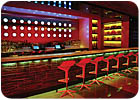
Inspirational Tribute
Located inside the Mirage hotel and casino in Las Vegas, NV, the Beatles Revolution Lounge offers an innovative reflection of the '60s era by using a variety of urban mineral-like materials such as slate. According to designer Stephanie Cardinal of Humá Design and Architecture of Montreal, Canada, the design goal was to create a space that related to the Beatles without mimicking the design of a typical Hark Rock Café type establishment.
"When we thought up the concept for the bar, we said that we wanted to pick up where the Beatles left off," the designer explained. "Their last performance was in Liverpool, CA, on a rooftop which was really urban -- with mineral materials. After working with the Abbey Road team, we decided to use slate, which had a look and feel that was used in the '60s era."
Ceragres of Montreal, Canada, supplied 1,000 square feet of slate for the project, and the material was used on the front and the sides of the bar. The material was preassembled at Humá Design and Architecture's headquarters, and then shipped to the jobsite. According to Cardinal, the slate pieces are each 12 inches long and vary from 1/2 to 2 inches thick. "All of the individual pieces were mounted onto nets that are 18 inches long by 12 inches high," she explained.
Another unique feature of the lounge is the changing colors of the bar lighting. "The concept starts in the era of the '50s which is represented by black and white," the designer explained. "As the evening goes on, the colors change turning to hot pink by the end of the night. As people bring more and more love and inspiration into the bar, the colors become brighter."
Construction of the project lasted for a six-month duration, and the lounge opened for business in December of 2006. "It was a very demanding project because everyone working on it had something to add, and all expected a high level of quality and creativity," said Cardinal. "In the end, the client was very enthusiastic about the result. In fact, just today I received mail from a customer who said the project was brilliant."
